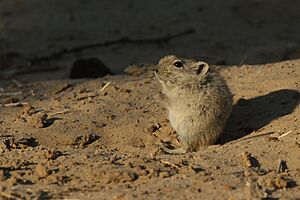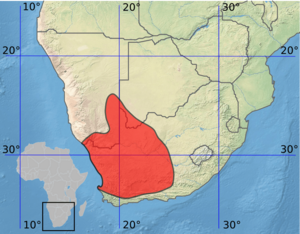Brants's whistling rat facts for kids
Quick facts for kids Brants's whistling rat |
|
|---|---|
 |
|
| In Kgalagadi Transfrontier Park | |
| Conservation status | |
| Scientific classification | |
| Genus: |
Parotomys
|
| Species: |
brantsii
|
 |
|
| Brants's whistling rat range | |
| Synonyms | |
|
|
Brants's whistling rat, also known as Brants' whistling rat (Parotomys brantsii), is a type of rodent. It's one of two species in its group, called Parotomys. You can find these rats in parts of Botswana, Namibia, and South Africa. They live in dry areas with shrubs and grasslands. A Scottish scientist named Andrew Smith first described this rat in 1834. He named it after a Dutch scientist, Anton Brants.
What Does Brants's Whistling Rat Look Like?
Brants's whistling rat is a fairly large rodent. It has a short, rounded head. Male rats are usually about 215 mm (8.5 in) long from head to body. Females are a bit smaller. Their tail is about two-thirds the length of their body, measuring 7.5 to 10.5 cm (3.0 to 4.1 in).
The rat's head is greyish-white. Its nose and forehead have a reddish-brown color, called rufous. Its ears are large and round, with dark skin and short hairs. The fur is thick and soft. On its back, the fur is yellowish with brownish-black spots. Each hair has a dark grey base and a yellowish tip. There are also some long, black hairs, especially along its spine.
The sides of the rat are lighter in color. Its belly is pale grey, with hairs that have pale grey bases and whitish or light yellow tips. Its legs are short. The front feet have four toes with long, narrow claws, and the back feet have five toes. The tail is covered with hair. It is dark brown on top and orangish-red on the sides and underneath.
How Does Brants's Whistling Rat Live?
This rat lives in a complex system of burrows underground. These burrows have many entrances and several rooms for nesting. In an area called Namaqualand, scientists found that the burrows covered an average of 73 m2 (786 ft2). They had an average of 93 entrances! Having so many entrances, some hidden and some open, helps the rat quickly hide from dangers.
Brants's whistling rats are active during the day. If they see a potential danger, like a bird of prey flying fast, they make a short, high-pitched whistling sound to warn others. If the danger is slower, like a snake, the whistle lasts longer. The number of rats in an area can change. In good breeding seasons, there can be more than 50 rats per hectare (about 2.5 acres).
These rats get all the water they need from the plants they eat. They don't have special body features to save water in their dry homes. They are active when the air temperature is between 23 and 37 °C (73 and 99 °F). The temperature inside their burrows stays fairly steady, even when it's very hot or cold outside.
Brants's whistling rats are most active in the early morning and just before dusk. They stay underground during the hottest parts of the day. When they look for food, they try to stay close to their burrow entrances. They rarely go more than 30 cm (12 in) away. Their diet includes leaves, stems, grasses, juicy plants called succulents, and bulbs. They do not eat seeds or other dry materials.
What is the Conservation Status of Brants's Whistling Rat?
Brants's whistling rat lives across a large area, including several protected parks. It is a common species, and its population has been stable for a long time. It doesn't face any major threats right now. Because of this, the International Union for Conservation of Nature (IUCN) has listed its conservation status as "least concern". This means it's not currently at risk of disappearing.
However, climate change might affect these rats in the future. They don't have special ways to deal with very high temperatures. This could make it harder for them to find food if their environment gets much hotter.



